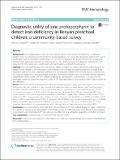| dc.contributor.author | Emily M Teshome, Andrew M Prentice, Ayşe Y Demir, Pauline EA Andang’o, Hans Verhoef | |
| dc.date.accessioned | 2020-08-14T07:50:00Z | |
| dc.date.available | 2020-08-14T07:50:00Z | |
| dc.date.issued | 2017-12-01 | |
| dc.identifier.uri | https://repository.maseno.ac.ke/handle/123456789/2114 | |
| dc.description.abstract | Background
Zinc protoporphyrin (ZPP) has been used to screen and manage iron deficiency in individual children, but it has also been recommended to assess population iron status. The diagnostic utility of ZPP used in combination with haemoglobin concentration has not been evaluated in pre-school children. We aimed to a) identify factors associated with ZPP in children aged 12–36 months; b) assess the diagnostic performance and utility of ZPP, either alone or in combination with haemoglobin, to detect iron deficiency.
Methods
We used baseline data from 338 Kenyan children enrolled in a community-based randomised trial. To identify factors related to ZZP measured in whole blood or erythrocytes, we used bivariate and multiple linear regression analysis. To assess diagnostic performance, we excluded children with elevated plasma … | en_US |
| dc.publisher | BioMed Central | en_US |
| dc.subject | Erythrocyte protoporphyrin, Inflammation, Iron deficiency, Kenya, Malaria, Plasmodium, Child, Preschool, Zinc protoporphyrin | en_US |
| dc.title | Diagnostic utility of zinc protoporphyrin to detect iron deficiency in Kenyan preschool children: a community-based survey | en_US |
| dc.type | Article | en_US |

